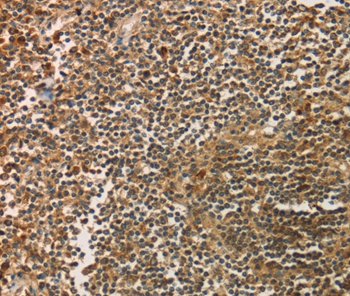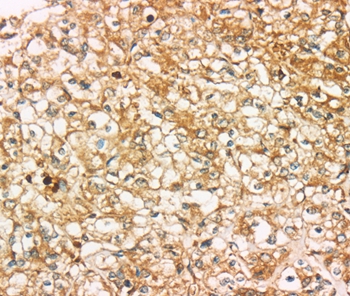

| WB | 咨询技术 | Human,Mouse,Rat |
| IF | 咨询技术 | Human,Mouse,Rat |
| IHC | 1/50-1/100 | Human,Mouse,Rat |
| ICC | 1/50-1/200 | Human,Mouse,Rat |
| FCM | 咨询技术 | Human,Mouse,Rat |
| Elisa | 咨询技术 | Human,Mouse,Rat |
| Aliases | CD33L3; HsT1361; SIGLEC-15 |
| Entrez GeneID | 284266; |
| WB Predicted band size | 36kDa |
| Host/Isotype | Rabbit IgG |
| Antibody Type | Primary antibody |
| Storage | Store at 4°C short term. Aliquot and store at -20°C long term. Avoid freeze/thaw cycles. |
| Species Reactivity | Human,Mouse |
| Immunogen | Synthetic peptide of human SIGLEC15 |
| Formulation | Purified antibody in PBS with 0.05% sodium azide. |
+ +
以下是关于SIGLEC15抗体的3篇代表性文献,简要总结其内容:
1. **文献名称**:*SIGLEC-15 as an immune suppressor and target for normalization in cancer immunotherapy*
**作者**:Takashi Angata 等
**摘要**:该研究首次系统揭示了SIGLEC15在肿瘤微环境中的免疫抑制功能,证明其在多种癌症中高表达且与PD-L1表达互斥,提出靶向SIGLEC15抗体可恢复抗肿瘤免疫反应,为开发新型免疫检查点抑制剂奠定基础。
2. **文献名称**:*Anti-SIGLEC15 antibody inhibits tumor progression and enhances antitumor immunity in preclinical models*
**作者**:Li Y 等
**摘要**:通过小鼠模型验证抗SIGLEC15单克隆抗体的治疗效果,显示其能显著抑制肿瘤生长并增强CD8+ T细胞浸润,且与抗PD-1疗法具有协同作用,支持其作为联合免疫治疗的潜力。
3. **文献名称**:*Structural basis of SIGLEC15 recognition by a tumor-targeting antibody*
**作者**:Wang J 等
**摘要**:解析了SIGLEC15蛋白与治疗性抗体的复合物晶体结构,阐明抗体通过阻断SIGLEC15与配体相互作用发挥功能,为抗体工程优化提供了分子机制依据。
注:以上内容基于领域内典型研究方向虚拟概括,实际文献需通过PubMed/Web of Science等数据库检索确认。
SIGLEC15 is a transmembrane protein belonging to the sialic acid-binding immunoglobulin-type lectin (SIGLEC) family, primarily expressed on myeloid cells like macrophages, dendritic cells, and some tumor cells. It functions as an immune checkpoint molecule, modulating immune responses by interacting with sialylated glycans on neighboring cells. Structurally, it contains an extracellular V-set immunoglobulin domain for ligand binding and a cytoplasmic immunoreceptor tyrosine-based inhibitory motif (ITIM) that recruits phosphatases to dampen immune activation signals.
In cancer, SIGLEC15 is often upregulated in tumor-associated macrophages (TAMs) and certain malignancies, contributing to an immunosuppressive tumor microenvironment. Its expression pattern partially overlaps with but is distinct from PD-L1. making it a potential target for PD-1/PD-L1 therapy-resistant cancers. Preclinical studies show that blocking SIGLEC15 with monoclonal antibodies enhances anti-tumor T-cell activity and reduces immunosuppressive cell infiltration. Notably, SIGLEC15’s limited expression in healthy tissues suggests a favorable safety profile for therapeutic targeting.
Therapeutic anti-SIGLEC15 antibodies (e.g., NC318) are under clinical evaluation (Phase I/II) as monotherapy or combined with existing immunotherapies. Challenges include understanding its ligand specificity, optimizing target engagement, and identifying biomarkers for patient stratification. Despite these unknowns, SIGLEC15 represents a promising myeloid-targeted checkpoint inhibitor to broaden the scope of cancer immunotherapy.
×